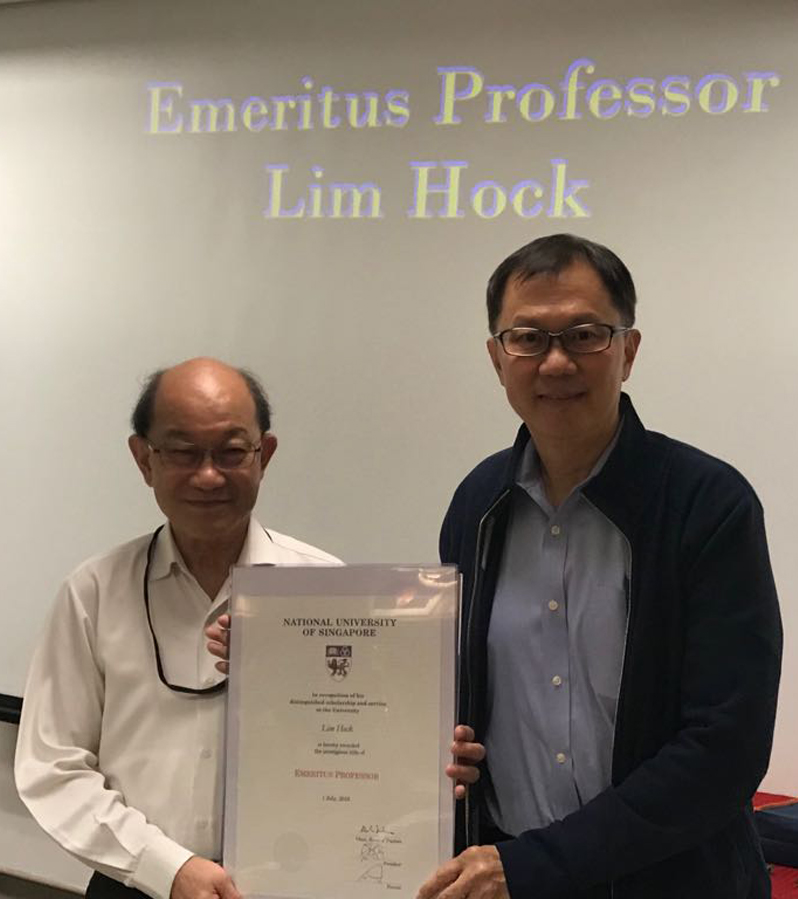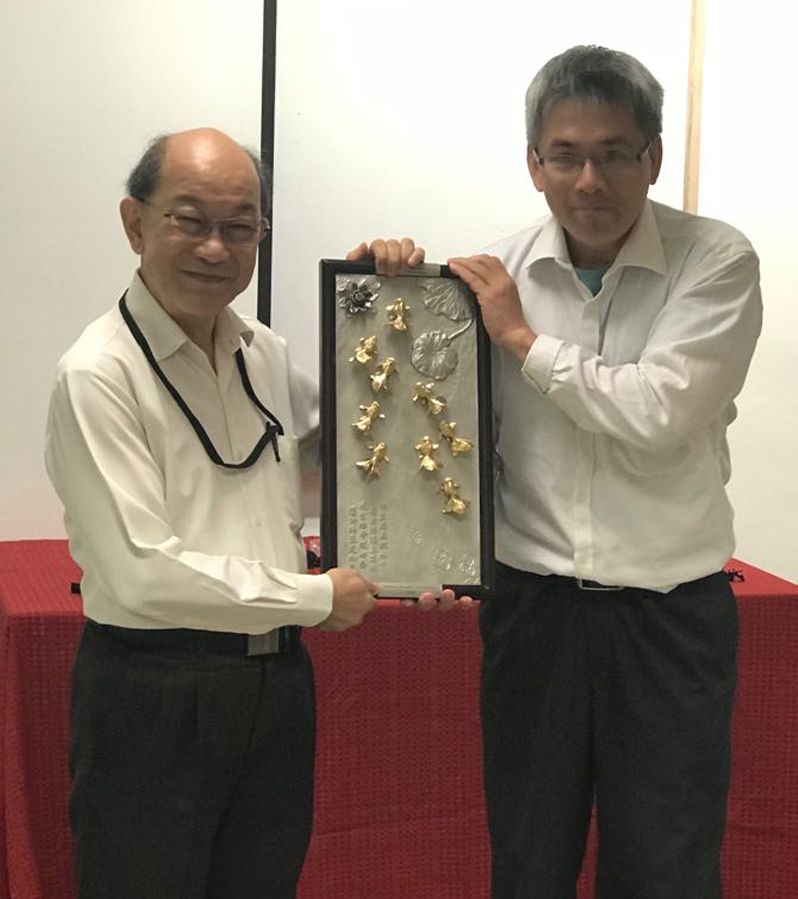Prof Lim Hock Conferred Emeritus Professorship
A ceremony to confer Prof Lim Hock from the Department of Physics as Emeritus Professor was held on 25 Jun. It is indeed an honour for the department that two of its faculty have been bestowed with this distinctive award with Prof Lim being the third. The award of Emeritus Professorship is conferred to full professors on retirement in recognition of their stellar and sustained contributions in distinguished scholarship and service to the university.
At the conferment ceremony, Prof Ho Teck Hua, Senior Deputy President and Provost, praised Prof Lim for his ability and fortitude to manage difficult problems. Though he was tasked to spearhead new initiatives that were immensely challenging, Prof Lim proved over and again that he was the right person for the job. Prof Lim has been instrumental in the setting up of the Centre for Remote Imaging, Sensing and Processing (CRISP), Temasek Laboratories (T-Lab) as well as the Singapore Nuclear Research and Safety Initiative (SNRSI).
Department head Prof Sow Chorng Haur shared about Prof Lim’s life journey, from his service in Meteorological Service Singapore, leadership role in CRISP and T-Lab, to his involvement in SNRSI. Prof Lim was also responsible for initiating the Computational Science Programme in the Faculty of Science and had served in the NUS Co-op for over two decades besides being on the management board of multiple university-level institutes. Prof Lim was also the recipient of multiple awards including the World Meteorological Organisation Young Scientist Award, Award for Outstanding Contribution to the MINDEF-NUS Joint R&D Cooperation Programme, The Institute of Physics Singapore President’s Award, Best Lecturer Award, and the Outstanding Alumni of the Faculty of Science Award.
Prof Lim expressed his appreciation for the Emeritus Professorship Award and attributed it to the many capable, friendly and supportive people and opportunities he met along his life journey. Prof Lim recounted how he had a chance to pursue a university education, the time he spent in the computerisation of some government services and the turn of events leading to his joining NUS. Then opportunity in defence research came. His first image processing experience was in collaboration with Dr Tan Kah Chye, who was then with the Defence Science Organisation. This led to further partnership with the Ministry of Defence which eventually led to the establishment of CRISP.
T-Lab offered Prof Lim another opportunity for a new challenge. The modest professor elicited much laughter from the audience when he acknowledged there were things in T-Lab he still had no idea about. Prof Lim was glad that a successor was finally put in place so that he could move on. When Singapore became concerned about the region going nuclear and the possibility of nuclear source as an energy input, the SNRSI initiative was launched. Prof Lim was again approached to lead this new initiative which he took in stride.
In his speech, Prof Lim expressed that he had been very fortunate throughout his whole life journey. The teams he worked with were hardworking, and there were always people who helped him and could be entrusted with responsibilities to perform their duties. One of Prof Lim’s concluding remarks perhaps best summed up his life achievements: “The history is not my history. The history is everybody’s in NUS.”


Citation for Emeritus Professor Lim Hock
Prof Lim Hock has been instrumental in many developments in Science and beyond, in Singapore. The following is a summary of some of Prof Lim’s distinctive contributions throughout his career.
- Centre for Remote Imaging, Sensing and Processing (CRISP)
Sometime in the mid 1980s, former Chief Defence Scientist Prof Lui Pao Chuen wanted to initiate the very first research collaboration between MINDEF and NUS. It was decided that the first joint project would be an image processing laboratory which was called LISP, the Laboratory for Image and Signal Processing. Prof Lim was the first and only director of LISP which was set up in NUS in 1988. The success of LISP persuaded MINDEF that a more ambitious joint project could be embarked on, hence the setting up of a full-fledged satellite remote sensing station which became the Centre for Remote Imaging, Sensing and Processing (CRISP), succeeding LISP.Prof Lim was the key person behind the setting up of CRISP which became fully operational by 1992. Starting from a position of complete inexperience in remote sensing, he was responsible for the drafting of the technical specifications, tendering of the antenna and all other equipment, assessment and selection of successful contractors, and supervision of the setting up, installation and testing of the remote sensing station. Prof Lim became the Founding Director of CRISP and, right from the start, established a very high standard of technical excellence. It is primarily due to him that CRISP quickly established itself as one of the leading and most widely respected remote sensing stations and research centres in the world. Under his leadership, CRISP won the coveted Excellence for Singapore Award in 1999. - Temasek Laboratories
The success of CRISP led MINDEF to establish the first Temasek Laboratories in a university for upstream research in topics of interest to MINDEF. Prof Lim became the first director of the NUS Temasek Laboratories in 2000 and built it up to become a well-respected research centre.On 6 Sep 2000, Temasek Laboratories was launched as a National University of Singapore research institute. Officiating the launch was Dr Tony Tan, then Deputy Prime Minister and Minister for Defence. In his keynote address, Dr Tan expressed his wish for Temasek Laboratories to evolve into a “third pillar” of national defence technology infrastructure, complementing DSO National Laboratories and the local defence industry in harnessing the potential of science and technology to enhance the security and defence of Singapore. (Source from T-Lab website)For his scientific and technical achievements and his contributions to MINDEF, Prof Lim Hock was awarded the Defence Technology Prize by MINDEF in 2003. - Singapore Nuclear Research and Safety Initiative
When he retired from the directorship of Temasek Laboratories in 2012, Prof Lim was again tapped for the directorship of a key research centre to be established in NUS–SNRSI, the Singapore Nuclear Research and Safety Initiative, which aims to- Attract, develop and sustain a community of nuclear experts;
- Host research laboratories and technical support capabilities;
- Develop relationships and collaborations with regional and international counterparts.
- Faculty of Science, NUS
Prof Lim played an important role in the setting up of the Computational Science Programme in 1990. This programme recognised the growing importance of computational modelling and simulation in scientific research, something which is taken for granted today as routine. Prof Lim headed the Computational Science Programme from 1990 to 1993 and contributed very significantly to its success. This led to the establishment of a full-fledged Department of Computational Science in the faculty in 1996.
